Authors
Moguloori. Sai Sowmya, A. Krishna Sailaja*
Department of pharmaceutics, RBVRR Women’s College of Pharmacy, Affiliated to Osmania University, Hyderabad.
Article Information
*Corresponding author: A. Krishna Sailaja, Department of pharmaceutics, RBVRR Women’s College of Pharmacy, Affiliated to Osmania University, Hyderabad.
Received: May 31, 2021
Accepted: June 16, 2021
Published: June 18, 2021
Citation: Moguloori. Sai Sowmya, A. Krishna Sailaja. “An Overall Review on Recent Advancements in Coating Techniques”. J Pharmacy and Drug Innovations, 2(4); DOI: http;//doi.org/03.2020/1.1019.
Copyright: © 2020 A. Krishna Sailaja. This is an open access article distributed under the Creative Commons Attribution License, which permits unrestricted use, distribution, and reproduction in any medium, provided the original work is properly cited.
Abstract
A numerous variety of coating materials and techniques are available for different coating applications with a most useful purpose for protecting a part or structure exposed to mechanical or chemical damage. The use of this protective function is to decrease the manufacturing cost. Some of the available coating materials include metallic alloys, ceramics, bio-glasses, polymers, plastic materials giving the designers a variety of choices for durable protection. Some of the coating techniques such as sugar coating, film coating, microencapsulation, compression coating, dry coating, melting coating, dip coating, rotary die coating, electrostatic coating has been introduced and investigated. Although each of these processes provides advantages, and also have drawbacks which are limiting to their application. However, there are many solutions to overcome the problems of coating techniques. In this article, some of the coating methods are categorized and compared. By developing the advancement in coating techniques and materials, it is possible to overcome the difficulties and enhance the qualities of protection in the future.
Keywords: Coating techniques; coating materials
Introduction
History of coating:
One of the earliest references to solid coated dosage forms which are present in early Islamic drug literature, where coated pills were introduced by Rhazes. Use of coating on drugs was probably adaption from early food preservation methods.
French publications in the 1600s described about the coating as a means of masking the taste of medicines. Sugar coating of pills was developed to an extent by French in themid-1800s.
Subsequently, there was a rapid acceptance of sugar-coated pills as the preferred solid dosage form for both prescription and patent medicines in Europe and the United States.
Except for the substitution of compressed tablets for pills, the sugar-coating equipment and process remained essentially unchanged for the next 75 years. In 1953, a dramatic change in tablet coating were made by the Abbott Laboratories, which marketed the first film-coated pharmaceutical tablet.
Concurrently, in the early 1950s, a professor at the University of Wisconsin, Dr. Dale Wurster, patented an air suspension coater which are efficiently applied at film coating compositions.
The invention by Dr. Wurster showed the merits of high airflow in the coating process, and eventually, a series of perforated coating pans (Accela-Cota, Hi-Coater, Dry-coater) were developed as replacements for the coating pans of the 30s and 40s [1].
Definition of coating:
A coating is a covering over a dosage form, used to mask the taste, make it easier to swallow, or protect the active medication inside. A coating colours and protects the tablet and makes a bad taste.
Tablet coating is the last crucial step in the tablet production cycle. It is the phenomenon of application of coating of the tablet.
Changes that have been occurred in coating processes reflects a desire to:
Obtain a finished product of high and reproductive quality.
Achieve processes in which the economics are maximized i.e., process times and equipment utilization.
Tablet coating principles:
The principles of tablet coating are relatively simple. The decision to coat a tablet is usually based on one or more principles of the following objectives:
- To mask and control the taste, odour, or colour of the drug.
- To provide the drug a physical and chemical protection.
- To protect the drug from the gastric environment of the stomach with an acid-resistant enteric coating.
- To incorporate another drug or formula adjuvant in the coating to avoid the chemical incompatibilities or to provide sequential drug release and to improve the pharmaceutical elegance by the use of special colours and contrasting printing.
Components considered in tablet coating:
- Tablet properties- Shape, tolerance, surface area
- Coating compositions- It involves polymers, colour, plasticizer, solvent.
- Coating process
- Coating equipment,
- Parameters of the coating process,
- Facility and ancillary equipment,
- Automation in coating processes.
Tablet properties:
- Tablet to be coated must possess the proper physical characteristics like spherical shape and uniform surface.
- To tolerate attrition of tablets during coating process they must be resistant to abrasion and chipping.
- As the tablet surfaces that are brittle and soften in presence of heat or effected by coating composition and tend to become rough in the early stages of coating process are unacceptable for film coating [2].
General Coating Process
General tablet coating process diagram:
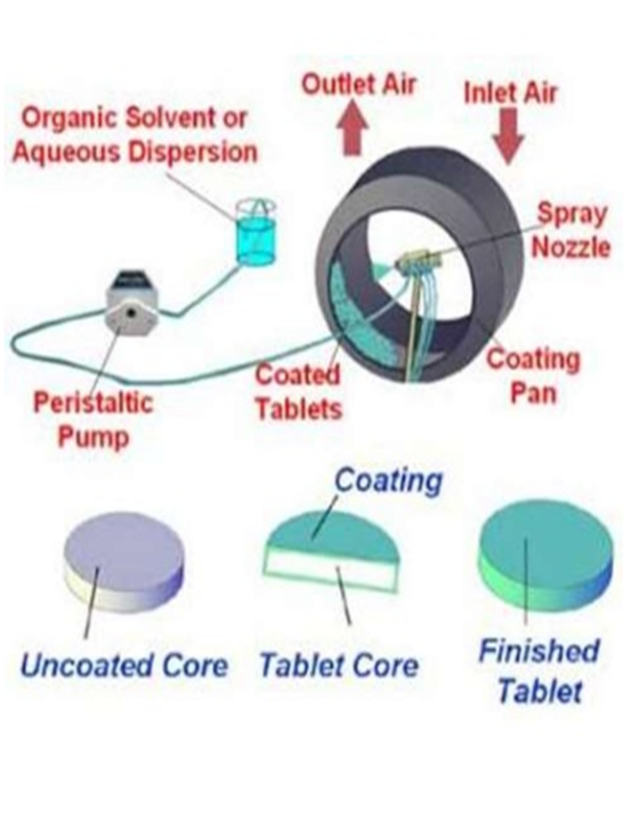
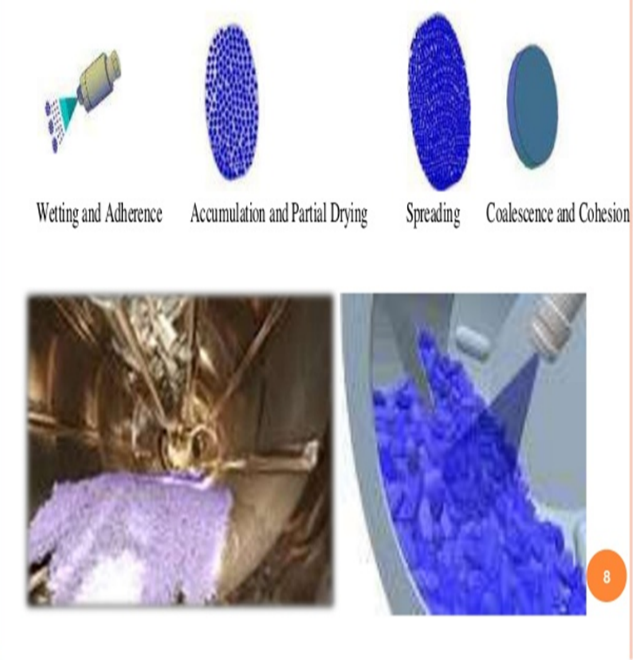
Fig.no:1- Figures of general coating process
Benefits of Tablet and Granule Coating
- Improved aesthetic quality.
- Masking of unpleasant taste or odour.
- Increasing the ease to swallow by the patient.
- Facilitating handling, particularly in high-speed filling/packaging lines.
- Improving product stability.
- Modifying drug release characteristics.
Equipment’s
The equipment’s used for the tablet coating are:
- Standard coating pan,
- Perforated coating pan,
- Fluidized coating pan.
- Standard coating pan:
- It is also known as conventional pan system and it has circular metal pan which is 8-60 inches in diameter.
- Air which is heated is directed into pan and then on to the tablet bed surface, where it is exhausted by means of ducts.
- Coating solution are applied to the tablets by spraying the material on to the rotating tablet bed.

Fig.no:2- Figure of standard coating pan
- Produces a faster, more and even distribution of the solution suspension.
- Reduces drying time between solution in sugar coating and allows continuous application of the solution in film coating.
- In standard coating pan, the drying efficiency is improved by:
- Pellegrini pan,
- The immersion pan,
- Immersion tube systems.
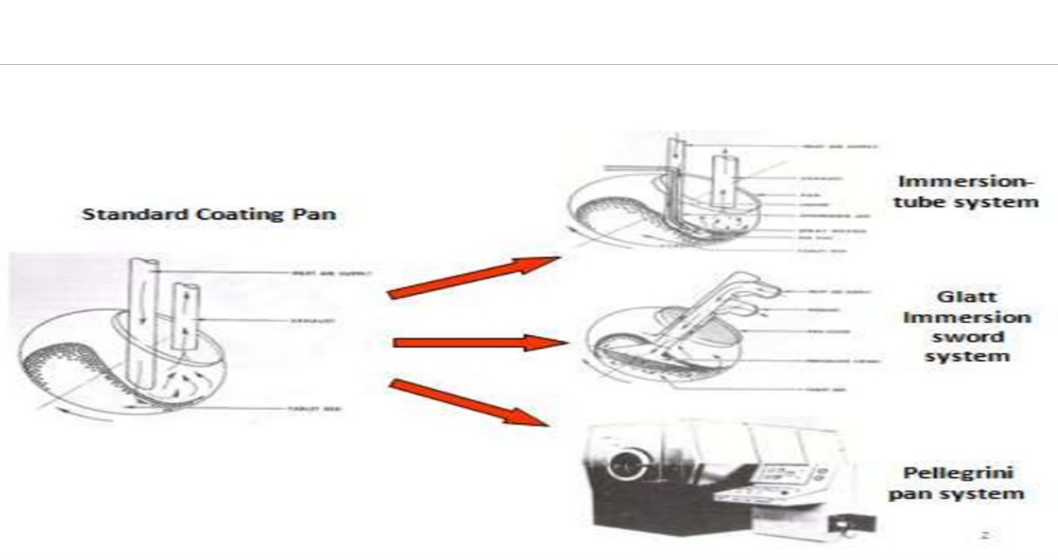
- Perforated pan systems:
- Perforated or partially perforated drums rotated on its horizontal axis in an enclosed housing.
- Coating solution is applied to the surface of the rotating bed of tablets through the spraying nozzles, which are present inside the drum.
- Perforated pan coaters are efficient in drying systems with high coating capacity.

Fig.no:3- Figures of perforated pan system
- Perforated pan system has:
- Accela - Cota system,
- Hi coater system,
- Drier coater pan,
- Glatt coater.
- Fluidized bed system:
- Fluidization of the tablet mass is achieved in a columnar chamber by the upward flow of air drying.
- The air flow is then controlled, so that more air enters into the centre of the column, which causes the tablet to rise in the centre.
- The movement of tablets is upward through the centre of chamber.
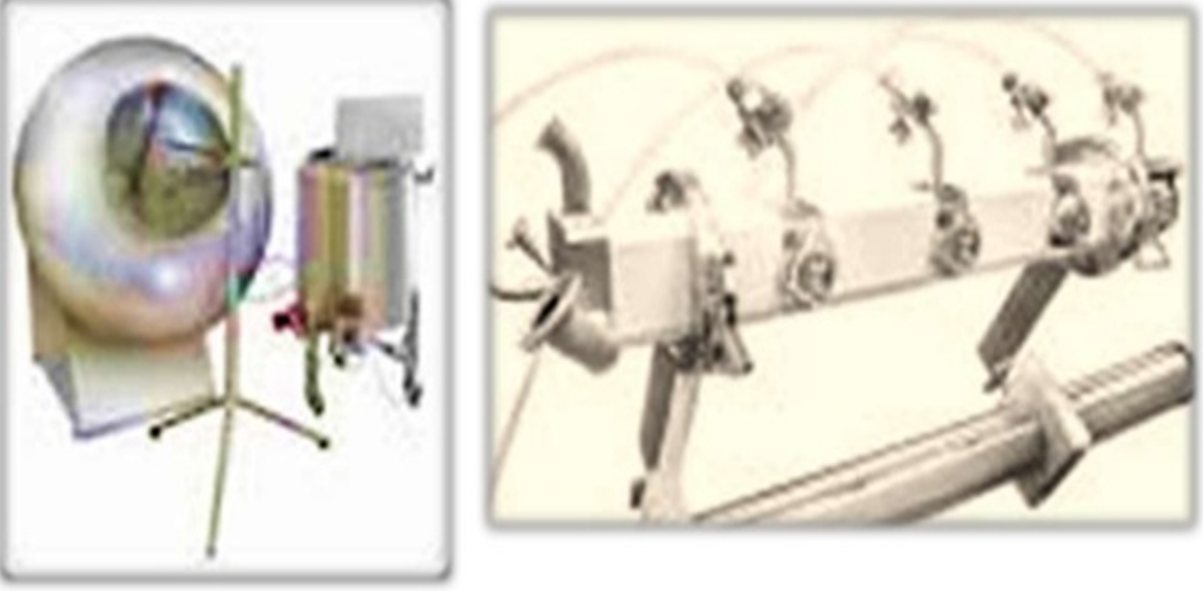
Fig.no:4- Figures of fluidized bed system
- Fluid bed coating machine mechanism:
- They fall towards the chamber wall and move downwards to re-centre the air stream at the bottom of the chamber.
- Solutions which are coated, applied from a spray nozzle which is located at the bottom of the chamber.
- Spray application system:
- Basic systems are used to apply a finely divided or atomized spray of coating solutions/suspensions on to the tablet, which are of 2 types:
- High pressure, airless.
- Low pressure, air atomized.

Fig.no:5- Figures of mechanism of fluidized bed system
The major pharmaceutical coating techniques are:
- Sugar coating,
- Film coating,
- Microencapsulation,
- Compression coating,
- Dry coating,
- Melting coating,
- Dip coating,
- Rotary die coating,
- Electrostatic coating.
- SUGAR COATING:
- It involves coating of tablets with sucrose.
- It is a highly skilled, multistep process which is very labour intensive.
- The process involves a number of aqueous solutions of sucrose, together which additional components, which gradually build up into a smooth, aesthetically pleasant coat.
- Raw materials used in sugar coating:
- The major ingredient is sugar(sucrose), although this may be substituted as sorbitol. A variety of additives may be incorporated:
- Fillers (Calcium carbonate, talc, titanium dioxide),
- Colorants (dyes, aluminium lakes, iron oxide),
- Film former (acacia, gelatine, cellulose derivates),
- Antiadhesives (talc), and Flavours,
- Surfactants (as wetting agents and dispersion aids).
- Advantages of sugar coating:
- Raw materials are easily available, inexpensive.
- No complex equipment can be used.
- Process is generally not as critical as film coating and recovery procedures are possible.
- Problems in sugar coating:
- Problems with tablets core robustness.
- Quality problems with finished products.
- Process of sugar coating:
- A typical sugar-coating process involves 5 stages:
1. Sealing,
2. Sub-coating,
3. Grossing,
4. Colour coating,
5. Polishing.

Fig.no:6- Figures of sugar-coating process
- Film Coating [4]:
- It is a complex process that involves the application of thin (in the range of 20-200µm) polymer-based coatings to an appropriate substrate (tablets, pellets, granules, capsules, powders, crystals) under conditions that permit:
- Balance between the coating of liquid addition rate and drying process.
- Uniformity of distribution of the coating liquid across the surface of product being coated.
- Optimization of the quality of the film coated product.
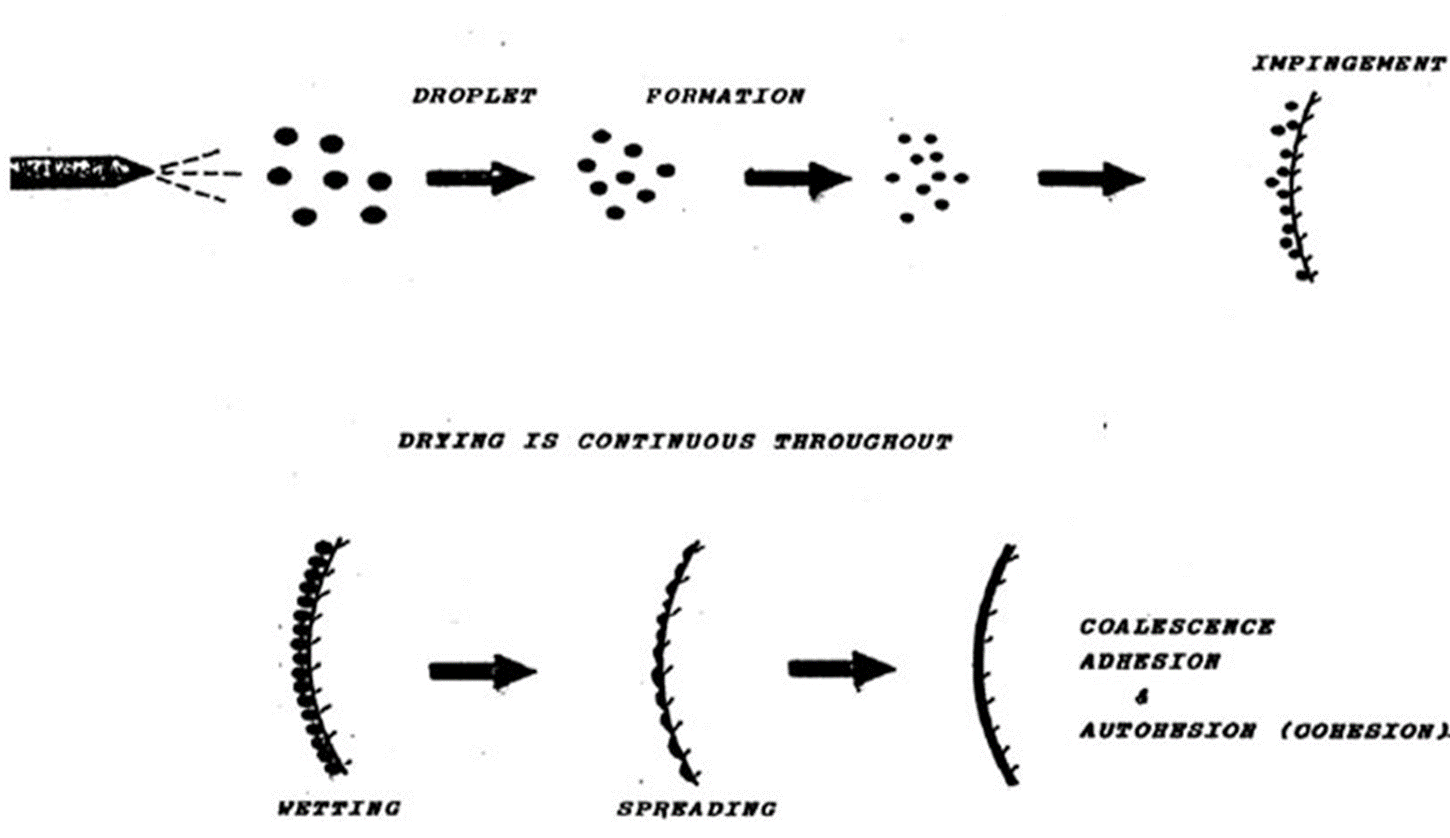
Fig.no:7- Figures of simple schematic film-coating process
- Ingredients used in film coating:
- Film-coating formulation consisted of an extensive list of ingredients, including:
- film formers,
- plasticizers,
- colorants,
- surfactants,
- flavours,
- glossing agents, and solvents.
- Advantages of film coating:
- Short production time and high degree of atomization.
- The quality of film coating is much lighter than that of the sugar coating, thus saving material & reducing the weight of the tablet.
- The film coated tablets are small in size and smooth in form, so it is easier for children and elderly patients to swallow.
- Film coated tablets have no restrictions on patients with diabetes, which expands the scope of use of patients.
- Problems in film coating:
- Picking,
- Twinning,
- Orange peel (Roughness),
- Edge wear (Chipping),
- Film cracking,
- Bridging of logos,
- Film peeling.
- Microencapsulation:
- It involves the encapsulation of small particles of drug (a particle size range between 1 & 2000 microns), or solution of drug, in a polymer coat.
- Microcapsules can be prepared by:
1. Coacervation,
2. Interfacial polymerization,
3. Physical methods.
- Advantages of microencapsulation:
- Masking of bitter taste drugs. E.g.: Ofloxacin
- Environmental protection. E.g.: Vit. A. Palmitate
- Reduction of hygroscopicity. E.g.: NaCl
- Reduction of vaporization of volatile drugs. E.g.: Methyl salicylate
- Prevention of incompatibilities among drugs. E.g.: Aspirin and Chlorpheniramine maleate
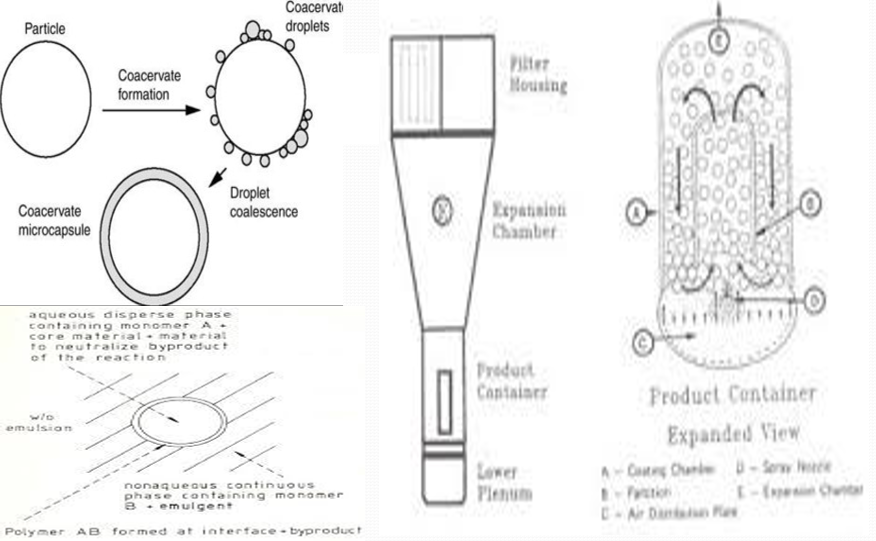
Fig.no:8- Figures of microencapsulation process
- Disadvantages of microencapsulation :
- Possible cross reaction between core and shell material.
- Difficult to achieve continuous and uniform film.
- Shelf life of hygroscopic drugs is reduced.
- More production costs.
- More skill and knowledge is required.
- Compression coating:
- It involves producing a relatively soft tablet core containing drug substance and compressing a coating around it.
- Advantages of compression coating :
- Elimination of bitter taste, unpleasant smell of API, water/other solvent in the coating procedure & thereby decreasing the possible degradation of the API.
- Easier and more economical manufacturing process.
- Stability of moisture sensitive drugs can be improved.
- Improve patient compliance by decreasing dosing frequency
- Both immediate & sustained release formulations can be prepared in single unit tablet.
- Desirable plasma drug concentration is maintained by continuous drug release.
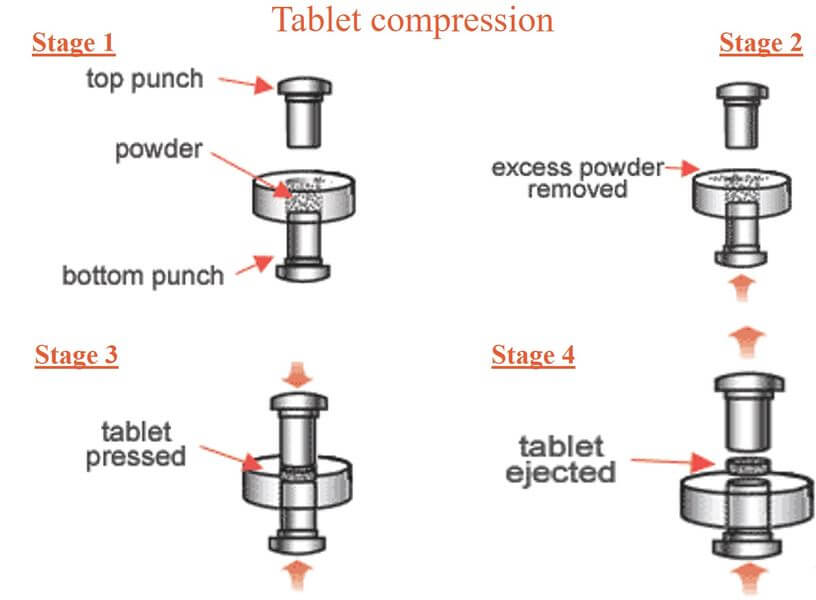
Fig.no:9- Figures of Schematic diagram of compression coating process
- Dry coating / powder coating:
- It involves the application of a polymer powder spraying the liquid plasticizer to the surface of appropriate substrates.
- Advantages and Benefits of powder (dry) coating :
- It is more durable and it can save money.
- Protecting the environment.
(A)Fluidized bed apparatus (B)Pan coating apparatus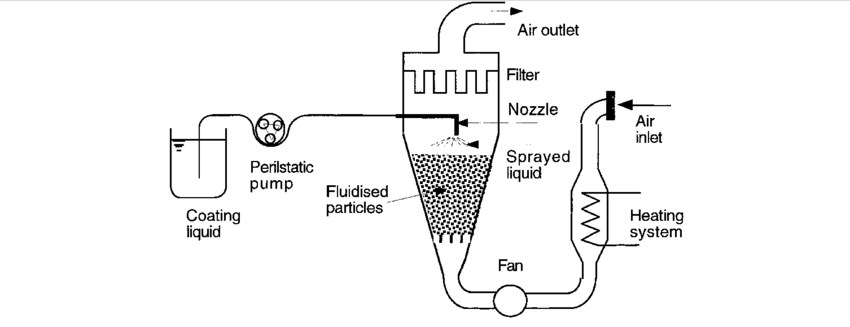

Fig.no:10- Figures of Schematic diagram of dry coating method
- Disadvantages of powder (dry) coating :
- Hard to achieve thin coating layers, color change difficulties.
- Will breakdown if exposed to UVrays, startup costs are high.
- Difficult to touchup and less control over smoothness, speed & amount of powder coating applied.
- Must be painted electrostatically and requires baking.
- Melting coating:
- An alternative to the application of polymeric solutions or dispersions is to select a coating material that can be applied molten. Top-spray fluizided-bed is used for melting coating.

Fig.no:11- Figure of Top spray coater diagram
- The selection criteria for coating materials also include:
- Melting point,
- Melting range,
- Viscosity (in a liquid state),
- Coating should have melting point of less than 85°c.

Fig.no:12- Figures of Insulated nozzle and wand for top-spray hot-melt coating
- Advantages of hot melt coatings are as follows:
- Environmentally friendly due to water and solvent-free adhesives.
- Low coating weight needed, high production speed possible.
- Elimination of dryer/low energy requirements.
- No thermal stress of substrate.
- Permanent or non-permanent adhesive coatings possible.
- Dip Coating [5]:
- It is applied to the tablet core by dipping them into the coating liquid & wet tablets are dried in conventional manner in coating pans.
- Alternate dipping and drying steps maybe repeated several times to obtain the desired coating.
- Dip coating has low cost and layer thickness can be easily adjusted.
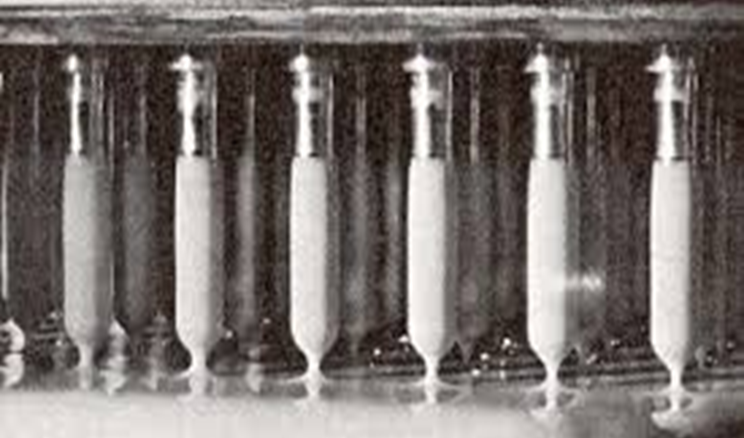
Fig.no:13- Figure of dip coating
- Dip coating is slow process.
- It has the ability to block the screen, which will create major impact in the final product.
- Rotary die coating:
- It is used the same equipment of rotary die process for preparing the soft gelatin capsules.
- The gelatin mass is substituted by coating liquid.
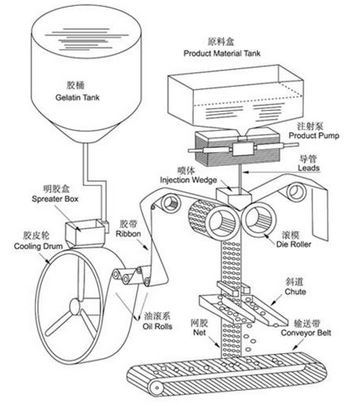
Fig.no:14- Figure of Schematic drawing of rotary die coating process
- Advantages of rotary die coating :
- Die cutting yields a level of uniformity in final product.
- Speed is also a positive factor.
- Cost is usually less than other forms of cutting.
- Cutting product causes no waste matter.
- Disadvantages of rotary die coating :
- It is generally not the method of choice for thicker materials.
- It can only be done within certain size constraints.
- Electrostatic coating [6 ]:
- It is an efficient method of applying coating to conductive substrates. A strong electrostatic charge is applied to the substrate.
- The coating material containing conductive ionic species of opposite charge is sprayed onto charged substrate.

Fig.no:15- Figure of Electrostatic coating diagram
- Advantages of electrostatic coating:
- Electrostatic powder coating has good corrosion resistance.
- It has no solvent, no waste pollution, & the working conditions have been improved.
- Use of new technologies such as electrostatic coating is high efficient to work, suitable for automatic coating lines. Powder has high utilization rate & can be recycled.
- It has long lasting and most durable quality finishes available for virtually any type of metal.
- Disadvantages of electrostatic coating:
- It requires the entire coating equipment, which is a huge investment.
- It requires rigorous maintenance and management.
- Poor management/improper operation can result in electric shock, high-voltage breakdown discharge, even fire accidents.
- It cannot be mixed with each other to obtain different colors, all powder colors must be produced to the final color match at the paint supplier’s factory.
Optimization parameters of coating:
- Type and concentration of coating agents,
- Number of coats,
- Amount of drug to be loaded in each coat,
- Coating techniques,
- Selection of coating materials or agents,
- Speed of nozzle and pan,
- Volume of coating agent,
Diameter and size of nozzle.


















